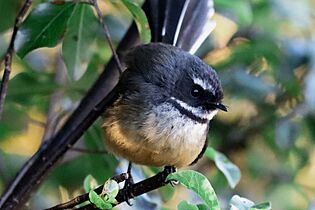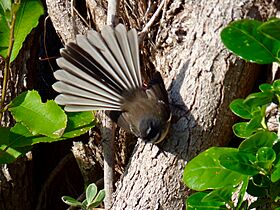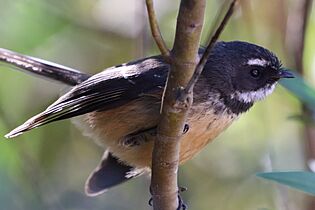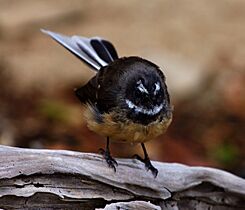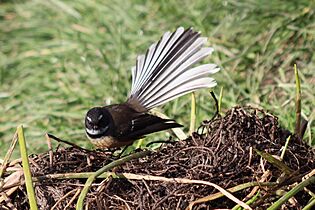New Zealand fantail facts for kids
Quick facts for kids New Zealand fantail |
|
|---|---|
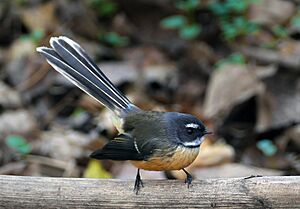 |
|
| New Zealand fantail | |
| Conservation status | |
| Scientific classification | |
| Genus: |
Rhipidura
|
| Species: |
fuliginosa
|
The New Zealand fantail (Rhipidura fuliginosa) is a small bird that loves to eat insects. It is the only type of fantail bird found in New Zealand. This bird is also known by its Māori names, pīwakawaka, tīwakawaka or piwaiwaka. The fantail from the Chatham Islands has a special Moriori name, tchitake.
There are four different kinds, or subspecies, of the New Zealand fantail. One lives in the South Island, another in the North Island, and a third on the Chatham Islands. Sadly, one subspecies that used to live on Lord Howe Island is now extinct.
Most New Zealand fantails have a mix of colors, often called the pied fantail. But some are all dark, known as the black fantail. For a long time, people thought this bird was the same as the grey fantail found in Australia. However, because their calls sound very different, many experts now say they are separate species.
Contents
Learning About the New Zealand Fantail's Name
The New Zealand fantail was first officially described in 1787. This was done by a Swedish scientist named Anders Sparrman. He gave it the scientific name Muscicapa fuliginosa. The word fuliginosa means "sooty," which describes its dark colors.
Later, in 1827, the fantail was moved to a new group called Rhipidura. This group now includes about 51 different kinds of fantails.
Different Types of New Zealand Fantails
Scientists recognize four main subspecies of the New Zealand fantail:
- R. f. fuliginosa: Found in the South Island and Stewart Island of New Zealand.
- R. f. placabilis: Lives in the North Island of New Zealand.
- R. f. penita: Found on the Chatham Islands, which are east of New Zealand's South Island.
- † R. f. cervina: This subspecies used to live on Lord Howe Island, east of Australia, but it is now extinct.
What Does the New Zealand Fantail Look Like?
This fantail is usually a mid to dark grey or grey-brown color on its back. Its belly is yellowish or orange. It has a dark band across its chest and a white throat. You can also see white markings above its eyes.
The bird grows to about 16 centimeters (about 6 inches) long. Half of this length is its tail! As its name suggests, the fantail often spreads its tail out like a fan. When it does this, you can see that the outer tail feathers are light, and the middle ones are dark.
Some fantails have a darker color all over. These are called "black fantails." About 4% of fantails in the South Island are black, and less than 1% in the North Island are black. Black fantails do not have the white areas; they are dark except for a white spot behind their eye.
Young fantails look similar to the adults. However, their bodies are a bit browner, and their markings are not as clear.
How the New Zealand Fantail Behaves
The New Zealand fantail is almost always moving during the day. It quickly flies from one branch to another, or sometimes even to the ground. It is always looking for flying insects to catch.
These birds are not shy. They often fly very close to people, especially in forests or gardens. They do this to catch small insects that people might disturb while walking or digging. When it gets cold, a group of fantails will huddle together to stay warm.
The fantail's call sounds like a sharp, almost metallic "cheek." They often repeat this sound, making a chattering noise.
New Zealand Fantail Reproduction and Life Cycle
New Zealand fantails breed during certain times of the year. In the North Island, they nest from August to March. In the South Island, it's from September to January. On the Chatham Islands, they nest from October to January. They usually raise two or more groups of babies each season.
The birds build small, cup-shaped nests. They often place these nests in the forks of trees. They use things like moss, bark, and plant fibers. They even use spider webs to help hold the nest together! Both the male and female fantail help build the nest.
A female fantail usually lays three to four cream-colored eggs. These eggs have grey and brown spots. The parents take turns sitting on the eggs for about two weeks until they hatch. Both parents also share the job of feeding the baby birds. Sometimes, the parents will start building a new nest and laying more eggs while their first group of babies is still being fed. Young male fantails can start having their own babies just two months after they learn to fly.
Sometimes, other birds called cuckoos will lay their eggs in a fantail's nest. This means the fantail parents end up raising the cuckoo chicks instead of their own.
Studies in Wellington showed that about 45% of fantail nests successfully raised chicks. About one in four nests were left empty, and just over one in four nests were attacked by predators like rats. Nests built on thin branches were safer from rats than those on thicker branches.
The Fantail in Māori Stories
In Māori mythology, the pīwakawaka (fantail) is seen as a messenger. It is believed to bring news of death from the gods to people.
One story says that the fantail's big eyes and quick, darting flight come from a time when the hero Māui squeezed it. He did this because the fantail would not tell him where his ancestor Mahuika, the fire deity, was hiding.
Tiwakawaka is also the name of one of the first Māori settlers who came to New Zealand.
Gallery
- New Zealand fantail / Pīwakawaka
See also
 In Spanish: Abanico maorí para niños
In Spanish: Abanico maorí para niños




